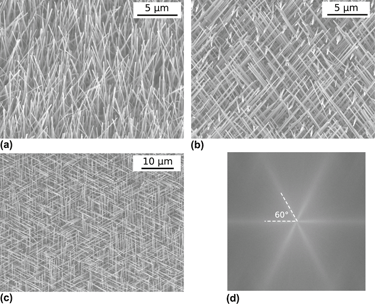Article contents
Controlled growth of ZnO layers and nanowires using methane as reducing precursor
Published online by Cambridge University Press: 25 July 2017
Abstract

Zinc oxide (ZnO) layers and nanowires were grown by chemical vapor deposition (CVD) using methane (CH4) as reducing agent. Compared to conventional CVD processes, which commonly use graphite powder to reduce the ZnO powder source material, this low-cost method allows an improved controllability of the growth processes. Specifically, the consumption of the source material–a commercially available ZnO powder–can be controlled in a very precise way by varying the flow of the reducing CH4 or the re-oxidizing O2. Using this parameter, the growth can be switched between ZnO layers and nanostructures. High-quality ZnO layers have been grown on gallium nitride (GaN) substrates and on c-plane sapphire with an intermediate aluminum nitride (AlN) nucleation layer. By adjusting the growth conditions accordingly, ZnO nanowires were also grown with this method catalyst-free using a- and c-plane sapphire with ZnO nucleation layer as a substrate. The optical properties of the nanowires were investigated by low-temperature photoluminescence (PL) and compared to samples grown by conventional carbo-thermal CVD.
Information
- Type
- Invited Articles
- Information
- Journal of Materials Research , Volume 32 , Issue 21: Focus Issue: Jan van der Merwe: Epitaxy and the Computer Age , 14 November 2017 , pp. 4087 - 4094
- Copyright
- Copyright © Materials Research Society 2017
Footnotes
Contributing Editor: Artur Braun
References
REFERENCES
- 6
- Cited by


